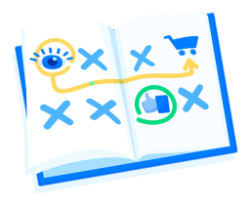
Unlocking the Benefits of Customer Journey Mapping
Customer journey mapping is the key to understanding your brand story from the customer’s perspective. By identifying pain points, needs, and distractions, you can effectively guide customers towards your product or service. Even if a sale isn’t immediate, nurturing long-term relationships through strategic mapping can lead to valuable customer journeys.

Navigating Customer Journey Maps with Precision
Customer journey mapping guides your understanding of customer behaviors and paths towards meaningful goals. By strategizing across various channels, you can reduce pain points and encourage customers to progress. Think of it as maneuvering a pinball machine, setting the course for customers while offering ways to keep them on track.
The Strategic and Tactical Roadmaps to Success
Two pivotal types of customer journey maps to consider are strategic and tactical. While strategic maps outline your business value strategy, tactical maps delve into the specific processes that align with your overall mission.
Crafting a Strategic Roadmap
Strategic roadmaps define your brand narrative and guide your team towards a common goal, especially during significant changes or product launches. These maps serve as the blueprint for aligning business functionality with customer experiences.
Detailed Tactical Plans
On the tactical level, customer journey maps provide a deeper dive into the execution of strategies laid out in the strategic roadmap. By focusing on specific processes and interactions, you can enhance the overall customer experience.

Mastering the Customer Journey Mapping Process
1. Define a Clear Goal
Start by establishing a specific goal for the customer journey, helping you determine the desired outcome and steps necessary to achieve success.
2. Establish a Baseline
Create a foundation for the journey by outlining a starting point, which often follows a straightforward route towards the end goal.
3. Identify Objections
Understand potential objections along the journey by analyzing customer feedback and addressing points of confusion or dissatisfaction.
4. Empathize with Customers
Put yourself in the customer’s shoes to gain valuable insights and create personalized touchpoints that resonate with their needs and preferences.
5. Leverage Tools for Success
Use a variety of tools and features to enhance the customer journey, from personalization techniques to retargeting strategies that keep customers engaged.
6. Implement and Adapt
Test your strategies in the real world, experiment with different approaches, and continually refine the customer journey based on feedback and data-driven insights.

Embrace Expert Guidance for Optimized Customer Journeys
Customer journey mapping has evolved into a multi-faceted approach that demands expertise in omnichannel experiences and technology integration. For efficient and effective planning, consider partnering with experienced professionals who can steer your strategy towards success.
Ready to get started?
Experience the power of personalized content with a guided tour of Contentful.

